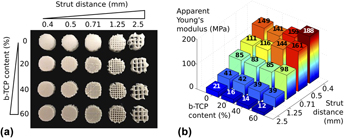Crossref Citations
This article has been cited by the following publications. This list is generated based on data provided by
Crossref.
Maruyama, Masahiro
Nabeshima, Akira
Pan, Chi-Chun
Behn, Anthony W.
Thio, Timothy
Lin, Tzuhua
Pajarinen, Jukka
Kawai, Toshiyuki
Takagi, Michiaki
Goodman, Stuart B.
and
Yang, Yunzhi Peter
2018.
The effects of a functionally-graded scaffold and bone marrow-derived mononuclear cells on steroid-induced femoral head osteonecrosis.
Biomaterials,
Vol. 187,
Issue. ,
p.
39.
Geven, M A
and
Grijpma, D W
2019.
Additive manufacturing of composite structures for the restoration of bone tissue.
Multifunctional Materials,
Vol. 2,
Issue. 2,
p.
024003.
Fan, Daniel
Staufer, Urs
and
Accardo, Angelo
2019.
Engineered 3D Polymer and Hydrogel Microenvironments for Cell Culture Applications.
Bioengineering,
Vol. 6,
Issue. 4,
p.
113.
Wang, Yichun
Bahng, Joong Hwan
and
Kotov, Nicholas A.
2019.
Three-dimensional biomimetic scaffolds for hepatic differentiation of size-controlled embryoid bodies.
Journal of Materials Research,
Vol. 34,
Issue. 08,
p.
1371.
Babilotte, Joanna
Guduric, Vera
Le Nihouannen, Damien
Naveau, Adrien
Fricain, Jean‐Christophe
and
Catros, Sylvain
2019.
3D printed polymer–mineral composite biomaterials for bone tissue engineering: Fabrication and characterization.
Journal of Biomedical Materials Research Part B: Applied Biomaterials,
Vol. 107,
Issue. 8,
p.
2579.
Ramírez, Jhon Alexander
Ospina, Valentina
Rozo, Angie A.
Viana, Maria I.
Ocampo, Sebastian
Restrepo, Sebastian
Vásquez, Neil A.
Paucar, Carlos
and
García, Claudia
2019.
Influence of geometry on cell proliferation of PLA and alumina scaffolds constructed by additive manufacturing.
Journal of Materials Research,
Vol. 34,
Issue. 22,
p.
3757.
Vazquez-Vazquez, Febe Carolina
Chanes-Cuevas, Osmar Alejandro
Masuoka, David
Alatorre, Jesús Arenas
Chavarria-Bolaños, Daniel
Vega-Baudrit, José Roberto
Serrano-Bello, Janeth
and
Alvarez-Perez, Marco Antonio
2019.
Biocompatibility of Developing 3D-Printed Tubular Scaffold Coated with Nanofibers for Bone Applications.
Journal of Nanomaterials,
Vol. 2019,
Issue. ,
p.
1.
Idumah, C.I.
Zurina, M.
Hassan, A.
Norhayani, O.
and
Shuhadah, I. Nurul
2019.
Nanostructured Polymer Composites for Biomedical Applications.
p.
139.
Haglund, Lisbet
Ahangar, Pouyan
and
Rosenzweig, Derek H.
2019.
Advancements in 3D printed scaffolds to mimic matrix complexities for musculoskeletal repair.
Current Opinion in Biomedical Engineering,
Vol. 10,
Issue. ,
p.
142.
Dave, Khyati
and
Gomes, Vincent G.
2019.
Interactions at scaffold interfaces: Effect of surface chemistry, structural attributes and bioaffinity.
Materials Science and Engineering: C,
Vol. 105,
Issue. ,
p.
110078.
Maruyama, Masahiro
Lin, Tzuhua
Pan, Chi-Chun
Moeinzadeh, Seyedsina
Takagi, Michiaki
Yang, Yunzhi Peter
and
Goodman, Stuart B.
2019.
Cell-Based and Scaffold-Based Therapies for Joint Preservation in Early-Stage Osteonecrosis of the Femoral Head.
JBJS Reviews,
Vol. 7,
Issue. 9,
p.
e5.
Shupp, Alison B.
Kolb, Alexus D.
and
Bussard, Karen M.
2020.
Tumor Microenvironment.
Vol. 1225,
Issue. ,
p.
1.
Murab, Sumit
Gruber, Stacey M.S.
Lin, Chia-Ying James
and
Whitlock, Patrick
2020.
Elucidation of bio-inspired hydroxyapatie crystallization on oxygen-plasma modified 3D printed poly-caprolactone scaffolds.
Materials Science and Engineering: C,
Vol. 109,
Issue. ,
p.
110529.
Grottkau, Brian E.
Hui, Zhixin
Yao, Yang
and
Pang, Yonggang
2020.
Rapid Fabrication of Anatomically-Shaped Bone Scaffolds Using Indirect 3D Printing and Perfusion Techniques.
International Journal of Molecular Sciences,
Vol. 21,
Issue. 1,
p.
315.
Moukbil, Yunis
Isindag, Busra
Gayir, Velican
Ozbek, Burak
Haskoylu, Merve Erginer
Oner, Ebru Toksoy
Oktar, Faik Nuzhet
Ikram, Fakhera
Sengor, Mustafa
and
Gunduz, Oguzhan
2020.
3D printed bioactive composite scaffolds for bone tissue engineering.
Bioprinting,
Vol. 17,
Issue. ,
p.
e00064.
Wang, Qing
Yang, Xiaojie
Wang, Guangfei
Wan, Leilei
Wang, Shiwei
Niu, Xiaoyong
Wu, Jiannan
and
Pan, Jinsong
2020.
Osteogenic growth peptide-loaded 3D-printed PCL scaffolds for the promotion of osteogenesis through the ERK pathway.
Materials & Design,
Vol. 193,
Issue. ,
p.
108811.
Tevlek, Atakan
Agacik, Dilara Turkel
and
Aydin, Halil Murat
2020.
Stretchable poly(glycerol‐sebacate)/β‐tricalcium phosphate composites with shape recovery feature by extrusion.
Journal of Applied Polymer Science,
Vol. 137,
Issue. 20,
Shanjani, Yaser
Siebert, Sean Michael
Ker, Dai Fei Elmer
Mercado-Pagán, Angel E.
and
Yang, Yunzhi Peter
2020.
Acoustic Patterning of Growth Factor for Three-Dimensional Tissue Engineering.
Tissue Engineering Part A,
Vol. 26,
Issue. 11-12,
p.
602.
Ghorbani, Farnaz
Li, Dejian
Ni, Shuo
Zhou, Ying
and
Yu, Baoqing
2020.
3D printing of acellular scaffolds for bone defect regeneration: A review.
Materials Today Communications,
Vol. 22,
Issue. ,
p.
100979.
Kang, Jin-Ho
Kaneda, Janelle
Jang, Jae-Gon
Sakthiabirami, Kumaresan
Lui, Elaine
Kim, Carolyn
Wang, Aijun
Park, Sang-Won
and
Yang, Yunzhi Peter
2020.
The Influence of Electron Beam Sterilization on In Vivo Degradation of β-TCP/PCL of Different Composite Ratios for Bone Tissue Engineering.
Micromachines,
Vol. 11,
Issue. 3,
p.
273.





